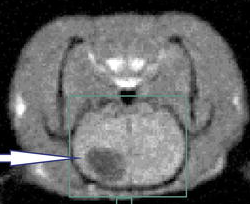Cell-phone-radiation study finds associated brain and heart tumors in rodents
May 27, 2016

Glioma in rat brain (credit: Samuel Samnick et al./European Journal of Nuclear Medicine)
A series of studies over two years with rodents exposed to radio frequency radiation (RFR) found low incidences of malignant gliomas (tumors of glial support cells) in the brain and schwannoma tumors in the heart.*
The studies were performed under the auspices of the U.S. National Toxicology Program (NTP).
Potentially preneoplastic (pre-cancer) lesions were also observed in the brain and heart of male rats exposed to RFR, with higher confidence in the association with neoplastic lesions in the heart than the brain.
No biologically significant effects were observed in the brain or heart of female rats regardless of type of radiation.
The NTP notes that the open-access report is a preview and has not been peer-reviewed.**
In 2011, the WHO/International Agency for Research on Cancer (IARC) classified RFR as possibly carcinogenic to humans, also based on increased risk for glioma.
* The rodents were subjected to whole-body exposure to the two types RFR modulation currently used in U.S. wireless networks — CDMA and GSM — at frequencies of 900 MHz for rats and 1900 MHz for mice, with a total exposure time of approximately 9 hours a day over the course of the day, 7 days/week. The glioma lesions occurred in 2 to 3 percent of the rats and the schwannomas occurred in 1 to 6 percent of the rats.
** The NTP says further details will be published in the peer-reviewed literature later in 2016. The reports are “limited to select findings of concern in the brain and heart and do not represent a complete reporting of all findings from these studies of cell phone RFR,” which will be “reported together with the current findings in two forthcoming NTP peer-reviewed reports, to be available for peer review and public comment by the end of 2017.”
Abstract of Report of Partial Findings from the National Toxicology Program Carcinogenesis Studies of Cell Phone Radiofrequency Radiation
The U.S. National Toxicology Program (NTP) has carried out extensive rodent toxicology and carcinogenesis studies of radiofrequency radiation (RFR) at frequencies and modulations used in the US telecommunications industry. This report presents partial findings from these studies. The occurrences of two tumor types in male Harlan Sprague Dawley rats exposed to RFR, malignant gliomas in the brain and schwannomas of the heart, were considered of particular interest, and are the subject of this report. The findings in this report were reviewed by expert peer reviewers selected by the NTP and National Institutes of Health (NIH). These reviews and responses to comments are included as appendices to this report, and revisions to the current document have incorporated and addressed these comments. Supplemental information in the form of 4 additional manuscripts has or will soon be submitted for publication. These manuscripts describe in detail the designs and performance of the RFR exposure system, the dosimetry of RFR exposures in rats and mice, the results to a series of pilot studies establishing the ability of the animals to thermoregulate during RFR exposures, and studies of DNA damage. Capstick M, Kuster N, Kühn S, Berdinas-Torres V, Wilson P, Ladbury J, Koepke G, McCormick D, Gauger J, Melnick R. A radio frequency radiation reverberation chamber exposure system for rodents Yijian G, Capstick M, McCormick D, Gauger J, Horn T, Wilson P, Melnick RL and Kuster N. Life time dosimetric assessment for mice and rats exposed to cell phone radiation Wyde ME, Horn TL, Capstick M, Ladbury J, Koepke G, Wilson P, Stout MD, Kuster N, Melnick R, Bucher JR, and McCormick D. Pilot studies of the National Toxicology Program’s cell phone radiofrequency radiation reverberation chamber exposure system Smith-Roe SL, Wyde ME, Stout MD, Winters J, Hobbs CA, Shepard KG, Green A, Kissling GE, Tice RR, Bucher JR, Witt KL. Evaluation of the genotoxicity of cell phone radiofrequency radiation in male and female rats and mice following subchronic exposure.